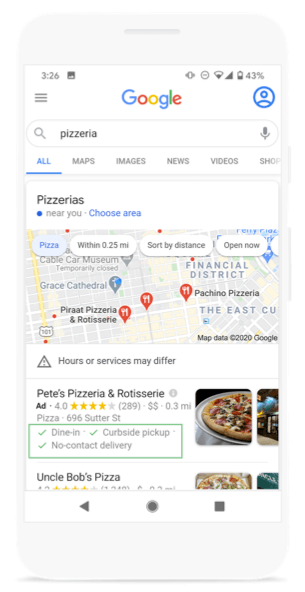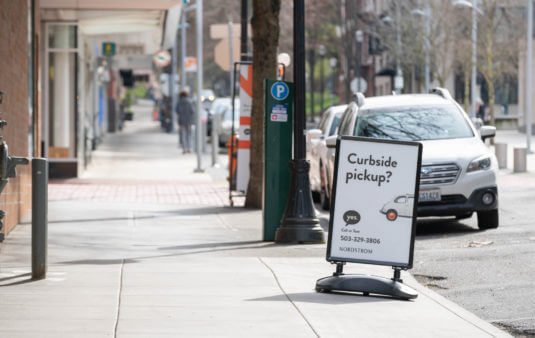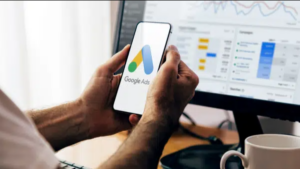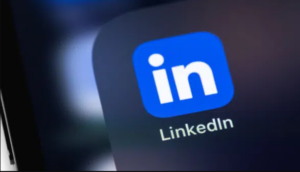The company is investing heavily to address the dominant online to offline use cases, including buy online, pickup in-store.
On Wednesday, Google is announcing several new enhancements for local ads:
- Service attributes for Local Campaigns.
- “Pick up later” for Local Inventory Ads.
- Smart Bidding optimization for in-store sales.
Attributes for Local Campaigns. There are dozens of local business attributes, which Google refers to as service attributes, available in Google My Business (e.g., online classes, curbside pickup, virtual care, contactless delivery). Most of them are category dependent: they’re different for restaurants and for hospitals, for example. Google is now bringing some of these service attributes to Local Campaigns for the first time.
Local Campaigns are specifically intended to drive consumers into physical stores and business locations. They’re one of Google’s automated campaign types that serves ads across various properties. Local Campaigns can appear on Google Maps, Search results (Map Pack and business listings), YouTube and the Google Display Network.
Local business service attributes in ads

These new ad attributes, such as curbside pickup, may be helpful to consumers trying to make buying decisions. However, as a practical matter, they’ll also make Local Campaign ads more visually prominent. That should make them more effective as well.
LIAs: Pick up later. In May Google fast tracked a “curbside pickup” badge for Local Inventory Ads (LIAs) in Google Shopping. There’s also a “pick up today” marker for Shopping ads featuring in-store inventory.
Now Google is adding a “pick up later” badge (e.g., “pick up by Wednesday”). In its blog post, Google said this gives retailers “the option to promote products that may not be available in store now, but can be available for pickup within a few days.”
In a briefing about these new features, Google VP of Performance and Programmatic Jason Spero explained, “If the item is not in stock in a particular store, but can be available for pickup within a few days, we think this meets the moment of how people want to engage with the world around them.” He added that the new option “has been met with a lot of excitement in betas and partnerships with retailers.”.
LIAs: Pick up later

The “pick up later” function will be managed via rules set for local inventory feeds in Google Merchant Center. It will be important (and potentially challenging) for retailers to get the logic right, especially with the holidays coming.
Smart Bidding for store sales. Smart Bidding for store visits has been around since last September. It optimizes bids for physical store visits, which Google measures using Android device locations, consumer panels and modeling. Smart Bidding for visits is focused on major retailers and large restaurant chains.
Now Google is extending that idea to in-store/restaurant transactions with Smart Bidding for store sales. It will automatically optimize against actual sales in stores, not merely foot traffic. Eligibility requires advertisers to meet certain in-store transaction volumes and data thresholds.
In its blog post Google said, “[A]dvertisers can upload their first-party, privacy-safe transaction data to inform ongoing optimization.” There are multiple ways to deliver store sales data to Google. Google Analytics reports “the total number of conversions influenced by your ads;” it doesn’t connect in-store sales to “individual ad clicks, viewable impressions, or people.” This bidding option will typically only be available to large, multi-location retailers with sufficient order volumes.
Why we care. Google is heavily investing in online-to-offline capabilities and functionality — and has sped up investment in the pandemic. More than its rivals, the company is building tools for both advertisers and users that address the most common internet use cases and shopping scenarios: research online, buy offline and the up and coming, “buy online pickup in store.”




